Why did the air conditioning flow, what should the owners do? Every owner of climate technology faces such a problem at least once. Water emerges from indoor unitflows along the wall, spoiling the finish or from the outside, dripping onto neighboring windows. It may get into electrical wiring or into a wall outlet.
What is dripping from the air conditioner and what are the actions of the owner?
During operation of the air conditioner, condensate is constantly forming on the evaporator. According to the drainage system, it is collected in a special container and displayed on the street with a special hose.
Causes of condensate drainage from the air conditioner and what to do in such cases:
- the drain pipe is not mounted correctly (15% slope towards the street is required). Disassemble the air conditioner and place the handset correctly;
- The tube was pinched or cracked, the joint was depressurized. It is necessary to replace the tube with a new, whole of high-quality material;
- If the sewer goes into the sewer, sometimes a “pseudo-siphon” is arranged: the hose is bent in a special way so that the gases from the sewer do not enter the room. Air conditioning is leaking because bending prevents condensate drainage. Solution: change the pseudo-siphon to a special siphon for the air conditioner;
- The system is clogged. Mold or dirt can accumulate in the condensate bath, drain hose, or water outlet. Solving the problem of condensate drainage from the air conditioner: clean or blow out the drainage system. You can use special cleaning products for this or call specialists, saying that water is flowing from the air conditioner.
Flowing from the outdoor unit
The outdoor unit has flowed, what to do and what is the reason?
Reasons to leak outside:
- Lack of freon in the system. On the pipes frost and ice freeze, which gradually melt and water drips from the outdoor unit. What to do: refuel the air conditioner;
- Dirty evaporator. The air conditioner flowed because dust, dirt and fluff interfere with the heat exchange between the evaporator and atmospheric air. He freezes and “cries”;
- With frost on the street, the pressure in the freon conduit and the temperature of the evaporator decrease. In such cases, the equipment is equipped with a condensation pressure regulator. Air conditioners operating in rooms with a special microclimate (server rooms) are initially equipped with this regulator.
Dripping air conditioning neighbors
For some owners, a completely different problem is connected with the outflow of condensate: the air conditioning of the neighbors is dripping. Drops fall on a window, window sill or outdoor unit lower air conditioner. If the air conditioning of the neighbors is dripping, you need to ask them to unscrew the outlet of the drainage tube from your windowsill a little. It is advisable to cover your outdoor unit with a protective visor.
Worse if the radiator of an air conditioner drips. In this case, you will have to call the masters and solder the radiator. The air conditioner radiator may leak due to wear or mechanical stress.
During the operation of any air conditioner, excess water flows out, which is formed during the dehumidification of the air, but when the liquid appears in the most unexpected places, you should think: something in the device’s work went wrong. After all, the natural moisture from the operation is poured into special containers, and then displayed in the sewer. It is worthwhile to immediately determine why the air conditioner is dripping, so that then you do not carry out expensive repairs or buy a new split system. Naturally, it is best to contact a professional, but if the air conditioner is flowing indoors, then in some situations you can handle it yourself.
Causes of water from the air conditioner indoors
The reasons that cause leakage of the split system are many, so it is worth considering more carefully each of them.
Temperature difference
Sometimes drops from the air conditioner may appear due to the banal temperature difference on the street and indoors. At low street temperatures, the condensate turns into ice, and in the morning it already melts and leaks in the form of drops. To solve this problem is quite simple: you should insulate the sector in which the heat exchanger is located. For such purposes, you can use ordinary glass wool. After doing insulation work leakage problem will end.
Incorrect installation of the system or its elements
There may be several options.

Depressurization
Another reason why there are drops of water indoors after a period of use may be weakening of branch pipes or their depressurization. What to do in this case? You can cope with the problem yourself, for this it is enough to follow these steps:
- gently tighten the nuts of the underwater nozzles;
- coat them with sealant to make the connection more reliable.
It is very important not to overdo it, since with great force you can break the thread, which will significantly increase the cost of repairs.
Drainage problems
In some cases, the air conditioner has flowed due to dust blockage filtration systems. Both the tube itself and the hole through which condensate escapes can become clogged. Nothing wrong with that. Today, a huge number of ways to clean such a system. Blowing, mechanical cleaning, or rinsing with solutions containing special chemicals will be used.
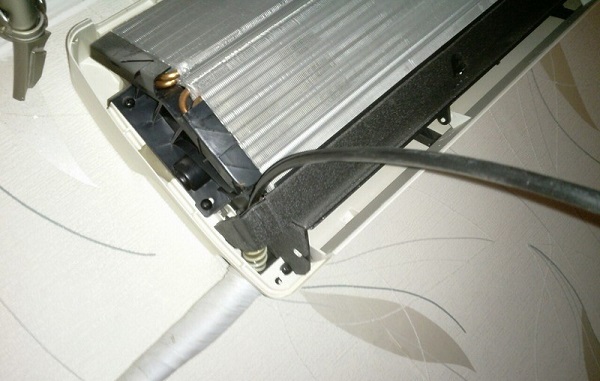
Ideally, it is worth disassembling the entire system in order to clean every element of it: a pan, a drain tank, a tube. But not everyone will be able to cope with the correct assembly after cleaning, so still it is worth inviting a specialist so that there are no unnecessary details.
When without a master you can’t cope with the problem
Unfortunately, there are situations that cannot be fixed on their own and the device requires inspection and repair by a professional craftsman. So, if water drips from an indoor air conditioner, you cannot rule out drainage pump breakdown. Its repair requires special knowledge and equipment.
If excessive pressure appears inside the housing, leaks can also form. They are caused by internal defects that you cannot fix on your own.
In conclusion, I want to note that the split system, like any technique, requires an attentive attitude. If you monitor the operation of the device and timely solve small problems, the equipment will delight its owner with excellent work for a long time.
So, you have a split system flowing, the picture is not pleasant: water is dripping directly from the body of the indoor unit of the split system. And it’s good if the water flowed from the split just to the floor, and not to your favorite furniture or expensive equipment. What happened? This post will answer this question.
The most common reason is pollution of the drain pan of the indoor unit of the split system.
Dirty drain pan of the indoor unit of the split system
This happens due to neglect of such a procedure as servicing or cleaning the split system. We will not repeat - read the article: how much cleaning is necessary for the air conditioner. In this article, in photographs of disassembled indoor units, you will see contaminants that fall into the drain pan.
Condensate draining on the pallet picks up dirt and carries it to the drain hole. The diameter of the hole is about 1 cm, that is, small. As a result, the drain becomes clogged over time, the drainage tank overflows and water flows through the body of the indoor unit of the split system into the room. The solution to this problem is basic preventive maintenance of the split system. The drainage system is completely flushed with this procedure.
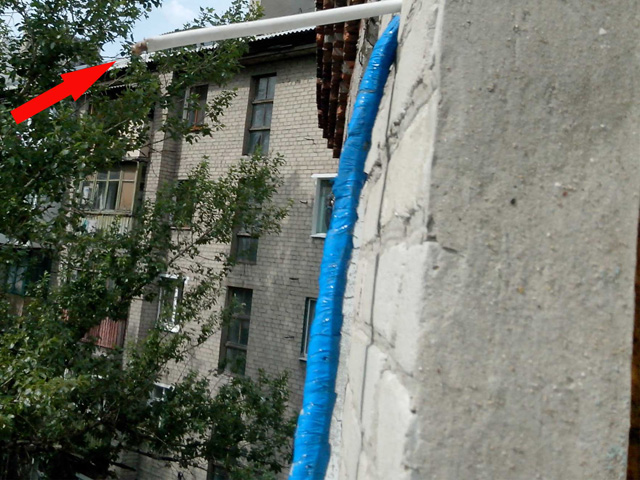
Clogged drain pipe of split system
The reason is simple: hot, dry summers, and drainage is a constant source of water. Naturally, all kinds of “living creatures” are trying to quench their thirst, and especially “enterprising” even settle right inside the drainage tube. It is worth noting that this phenomenon occurs mainly in the private sector and has no concrete solution, although particularly inventive clients attach a mosquito net to the end of the drainage tube, and this helps. But not for long, since the mesh is very quickly contaminated.
Let's leave our smaller brothers and move on to the concept of the human factor. In this topic it is difficult to describe everything that comes to the mind of a Slavic man ... Just cases from working days.
The high-altitude workers insulated the apartment from below ... "dripped" onto them and a solution was found! They smeared the drainage of neighbors from above. When we arrived, the high-altitude workers were no longer there, and the putty managed to dry thoroughly ... They pierced for a long time ...
Again climbers. This time, they simply bent the drain pipe upside down. We gave the pipe its previous shape - the problem is solved.
Repairs! Lower the ceilings. The split system is in the way. With simple manipulations (why should we call the air conditioners) we hang, without dismantling the freon pipeline, the indoor unit is slightly lower. The angle of the drainage is reversed and the water (condensate) does not flow outside, but into the apartment. Trouble. We come, drill a hole below, shift communication. There is no trouble.
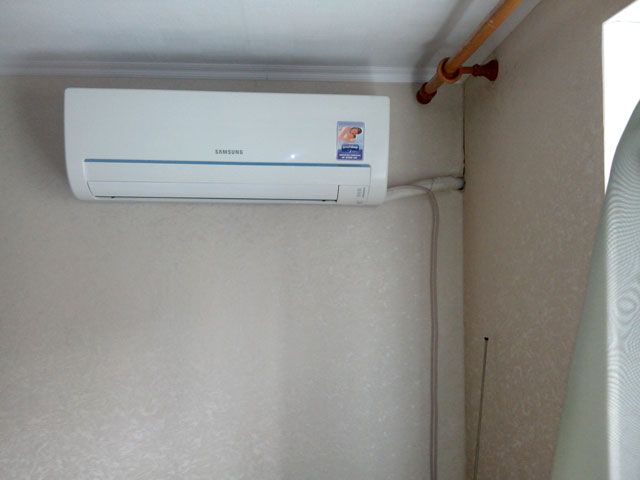
Freon pipeline of a split system with a reverse slope
It is also worth mentioning about low-quality installation. Using seasonal excitement, the “shabashniki” set up split-systems: fast, not expensive and not high quality. As a result of such work, condensate starts to flow from the split into the room.
There are basically four reasons: the first - the guys did not take into account that the hole must be drilled at a slight angle downward, so that the water under gravity flows naturally into the street. Apparently the guys with physics at school had difficulties ...
The second reason is the drainage pipe hall. This phenomenon occurs due to the use of low-quality materials (cheaper) or banal rush.
The third reason is not high-quality rolling. Consequences: Freon leakage and freezing of the heat exchanger. When you turn off the air conditioner or switch "to heat", melt water starts to flow from the indoor unit. Small pieces of ice and the appearance of extraneous noise are also possible.
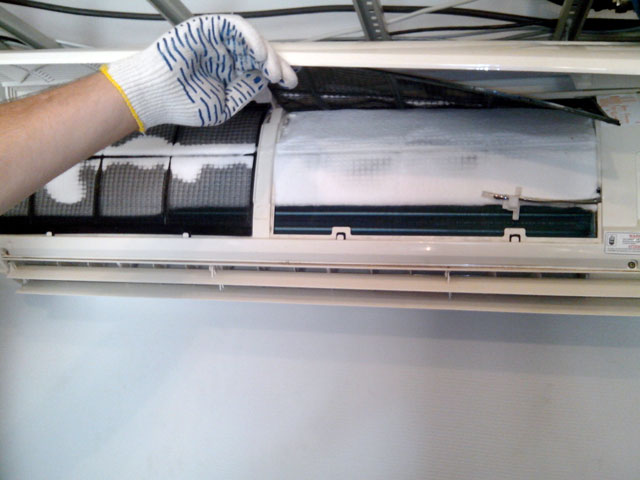
The fourth reason is the poor thermal insulation of the freon pipeline under the indoor unit of the split system.
You must have noticed that condensation is collected on cold objects. For example, if you remove a pot or glass bottle from the refrigerator, then water droplets will immediately appear on the surface. The process is quite natural. It seems to be a trifle, but without paying attention to it during the installation process, we get a leaked split.
To our logical question to the client: where are the installers who are required to eliminate all of the above problems for free? The predictable answer is: gone. Conclusion: cheap installation is expensive, because first you pay to the “co-workers” for their “work”, and then to the professionals for fixing the problems. It is important to note that in most cases the installation has to be completely redone, and pleasure is not cheap!
“Googling” the topic of a leaked split system, you will find some tips on how to deal with the problem yourself. The two main ones are to “blow” into the drainage tube and clean the drainage with a wire or cable. These are quite good advice, but not quite. With these manipulations you eliminate the consequence, but do not eliminate the cause.
When a tooth hurts, you can drink painkillers, but only going to the dentist will solve the problem radically. If the drainage is “purged” or cleaned with wire, a small hole will appear in the drainage system through which water will drain and the main pollution will remain. The drainage system will be completely clean only after flushing under high pressure of water.
Advice from us: disassemble the indoor unit, remove the drain pan, connect a high pressure washer to the drain pipe, rinse for 5-10 seconds. So we do. After this procedure, nothing but cleanliness remains in the drainage system.
At the end of the article we want to tell a case from the life of our company. Father-in-law called our manager and said that he had a split system. The manager’s response was: “You just blow the phone.” Imagine: a prominent man in a snow-white, ironed shirt approaches a drainage pipe ( a private house - access to drainage is elementary), and blows with all his might into the pipe ... After a second, a lot of very dirty water flows directly from the drainage onto a snow-white shirt.
There are a number of everyday problems that concern everyone without exception. About one of them, namely the dripping air conditioner, and I propose to talk. I am sure that everyone has come across this phenomenon, including those who have not yet decided on buying a BC or a split system (which of us or our friends didn’t get a loud knock on the windowsill of continuously dripping drops from the neighboring air conditioner on the windowsill? ) What can we say about the owners of the climate equipment themselves, trying to understand how the amount of condensate drained is related to the operation of the refrigeration unit. Let's see where the root of evil is the notorious problem and what can be done to solve it.
Why is water flowing?
We make a reservation right away: water from the air conditioner should drip in any case, since this is laid down in the principle of operation of the device. In order to make our stay in the room as comfortable as possible, the air conditioner simultaneously cools and drains the air. According to the laws of physics, water from the air condenses on something cold, that is, it settles on the cooling system, after which it flows into a special tray, and through a branch pipe flows either into the sewer, or, much more often, into the street.
Air conditioners are hung on the window, and water is dripping, respectively, from their outside. Split systems collect water in the indoor unit (after the maximum allowable amount of liquid accumulates in the indoor unit, it is discharged into the outdoor unit, where it can be used to cool the split system itself) or simply take it out.
Significant issue if the indoor unit is dripping - in this case, it is likely that the drain pipe is damaged or clogged. And if it does not drip at all, then the air conditioner simply does not fulfill one of its main purposes - it does not drain the room air.
In general, it is estimated that in the summer, the daily rate of water flowing from the BK reaches up to 14 liters per day (when conditioning the average size of the room). This is technical water and it is absolutely impossible to use it to quench your thirst (since it contains a large percentage of microbial infection and the content of heavy metals - zinc oxide, iron, lead, etc.)
Possible condensate problems, their causes and solutions
Remember how the vast majority of articles on household air conditioners? That's right, “do not trust anyone to get the air conditioner installed. Having saved on the installation, you will subsequently lose much more money and nerves on the repair ”- in one way or another, experts who own the problem advise without exception.
If the installation of air conditioners is carried out professionally and in compliance with all requirements, then it will flow in the above places and quantities. An incorrect installation can be fraught with many troubles, up to the breakdown of the condensing unit itself:
Water leaks that form inside the apartment can ruin the wallpaper, walls, furniture and floor, and even lead to the formation of mold or mildew. The amounts of condensate discharged outward are much larger than stipulated by the operation, they knock on the windowsill of the neighbors from below, splash windows, spoil the facade of the house, lower balconies and visors of the porches.
So if you want to enjoy a comfortable stay in your own house all year round, and at the same time you are not a lover of protracted wars with your neighbors, engineering services and HOAs, then contact the competent specialists who will ensure that your split system or air conditioner is installed in accordance with with technical and construction standards and requirements. Moreover, the service "purchase + installation" is now offered by most large companies involved in the implementation of air conditioning systems.
Such a useful device as an air conditioner, which gives the desired coolness in the summer, can in some cases cause problems. It happens that in the process of cooling air, water drips or flows from it. This is not very pleasant, especially if the device started to flow suddenly and there is no one to turn to for help. Moreover, if this happened indoors - in an apartment or in a room, and water runs directly from the indoor unit of the cooling device, and it is good, if only on the floor. What are the reasons that the air conditioner flows into the room, and not through the pipe to the street, as it should be?
Causes of the course
- If the cooling system has been operating at full strength for a long time — and, as a rule, it happens in hot summers — the condensate collection tank is simply overflowing, and when it is ready, the device flows into the house, not the street.
- In winter, the heat-exchanging part of the air conditioner can be covered with ice, and this in turn leads to the formation of condensate from the working fluid. He begins to flow. Freezing occurs if the outdoor temperature differs significantly during the day and night.
- The drainage system of the air conditioner may fail, due to which condensate does not enter a special tank, but drips or flows.
- The drainage hose may not be in the correct position, as a result of which the liquid simply does not rise in the right direction, and the split system starts to flow.
- The circuit was depressurized due to the fact that the pipes leading the fluid into the system were weakened, and it flows drop by drop.
- Excess fluid may be inside the circuit, resulting in increased pressure. This problem is quite serious, because in the end it may turn out that your air conditioner did not just flow, but it broke.
The flow of the split system looks as follows:
What to do?
Consider how to fix the malfunction with your own hands:
- In the first case, there is nothing complicated - you need to pour out the condensate accumulated there from the tank, and then install it in place, and the split system will work fine. Of course, this must be done after turning it off and, preferably, after washing. Watch for condensation to prevent leakage.
- If the air conditioner flows due to the ice coating of the heat exchanger, then make thermal insulation, for example, using glass wool, so that there is no such reaction to temperature changes.
- In the event that the drainage pump breaks down and flows, it must, of course, be repaired or replaced, but for this you should contact air conditioning specialists who will perform the repair and diagnostics at the proper level.
- If water is dripping because the hose is not placed correctly, then place it under the necessary slope.
- Weak attachment of the nozzles can be improved by strengthening the fasteners with nuts, and for the strength can be treated with sealant. But do not pinch until the thread breaks.
- Constantly check the amount of fluid so that there is no excessive accumulation, and the split system does not leak.
Another cause of failure is clogging of the drainage tube. How to fix this malfunction with your own hands is described in the video:
Drainage cleaning
Thus, part of the causes of leaks of the air conditioner may well be eliminated on its own. But in more complex cases, it is better, of course, to turn to specialists. For example, such a moment when the indoor unit flowed. Here the reason, most likely, will be the presence inside the defects - chips, cracks. Of course, you can try to fill them with a bonding agent, but it is better to entrust the analysis of the device to a specialist.
Here are a few more comments and tips from professionals who are involved in the installation, commissioning, and repair of refrigeration appliances. In general, they call the clogging of the drainage tank the most common reason that the air conditioner is leaking. If you neglect its service cleaning, then in the end it will become clogged. Dirt, wasps, spiders, and other insects get into the tube. The question often arises - what do insects do inside the tube? They, like all living things in the summer, are attracted to water. Some even settle there. The inventive owners of air conditioners sometimes put on a mosquito net at the end of the tube, but it also clogs over time.
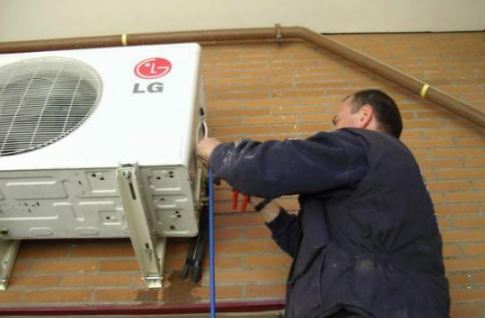
Since the hole diameter of the drainage tube is about 1 cm, and it becomes clogged, when the split system is working, water drips through the indoor unit into the apartment, not through the tube into the street. The solution to the cleaning problem is best left to specialists. After turning off the air conditioner and after flushing it, the problem will be completely eliminated, the drainage system is cleaned.
Often, an independent human factor is to blame for the fact that water is dripping from the hull. So, during the repair, it happens, you need to rearrange it a little higher, lower, or to the side (especially when the repair touches the ceilings in the room). In this case, if this is done without the participation of specialists, the angle of inclination of the drainage may change, and water does not flow into the street, as expected, but drips into the room. Here you can’t do without the participation of service workers, because you need to drill a new hole and relocate the communication anew. In addition, during the currently popular high-altitude warming works, industrial climbers, as experience shows, can cover the drainage with putty (if it drips from the neighbors) and bend up the end of the drainage tube. Here, of course, in order to eliminate the leak, it is necessary to redo the intervention of negligent workers.
Cheap installation costs more
Also, the reason that the water runs in the apartment or in the room, and not on the street, may be elementary low-quality, but also inexpensive installation. The following factors are often highlighted here:
- The hole was drilled directly into the quick arm, and not at a slight angle, as expected (then, of course, the water flows into the street, and not into the room).
- The drainage tube may be broken due to the use of low-quality materials or simple work in a hurry.
- Poor rolling, because of which freon flowed, and, as mentioned above, the heat exchanger froze. As a result, melted water flows, ice falls out when the air conditioner turns off.
- The freon conduit is poorly insulated. Because of this, condensation collects and starts to flow.
So that cheap installation is more expensive, because the customer will pay first for low-quality installation, and then - to eliminate its consequences. And in many cases, the installation has to be started anew, and as a result, the client will pay two, or even three times more! Conclusion - Trust

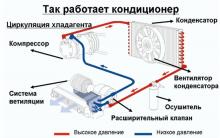
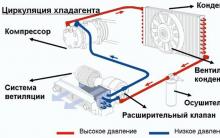
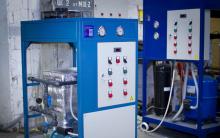
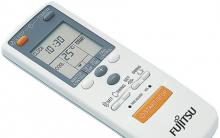

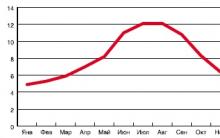




The best material for car trim
Principles of hardening the body
Do-it-yourself compressor - with minimal scrap costs
Which is better: do-it-yourself or factory-made compressor for painting a car
Causes of fuel pump malfunctions